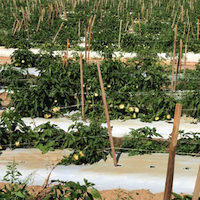With the state’s late summer and fall vegetable crop close to harvest, Georgia vegetable farmers estimate more than $480 million in losses from Hurricane Michael.
For the last few days, the University of Georgia Vegetable Team has been visiting farms to account for losses from Hurricane Michael on the vegetable crops grown during the fall season.
Losses varied significantly across southwestern Georgia counties. For some vegetable farmers in the direct path of the storm, losses approached 90 percent, while others on the edges of the storm saw lower losses, estimated around 20 to 30 percent. Even a 20 percent loss is quite significant for an individual farmer, said Greg Fonsah, UGA Cooperative Extension agricultural economist, who was charged with calculating the crop loss and its economic impact.
The storm, which made landfall on the panhandle of Florida as a Category 4 hurricane on Oct. 9, is estimated to have caused at least $1 billion in agricultural losses as it passed through southwest Georgia late last week, according to an early estimate released by the Georgia Department of Agriculture.
The state’s vegetable industry, valued at $1.14 billion according to the 2016 Georgia Farm Gate Value Report, is centered in southwest Georgia, with significant acreage in some of the counties hardest hit by Hurricane Michael. Farmers and UGA Extension vegetable specialists and county agents have been inspecting fields to develop more precise damage estimates.
The severity of the damage varies widely depending on location, said Timothy Coolong, UGA Extension vegetable horticulture specialist, who traveled through the state on Oct. 15. UGA Extension vegetable horticulturist Andre da Silva, plant pathologist Bhabesh Dutta and Fonsah joined him on farms in Tift, Worth, Turner, Colquitt and Grady counties. Extension agents Scott Carlson of Tift County, Jeremy Kickler of Colquitt County, and Ty Torrance of Grady County met with the UGA Vegetable Team during their visits.
Vegetable farms in areas farther east, particularly those east of I-75, may see minimal losses. Farther west, farms are observing losses ranging from 35-100 percent.
For instance, the specialists inspected a pepper farm in Lake Park, Georgia, that looked relatively unscathed while the pepper crop at a large farm in Tifton, Georgia, just 60 miles northwest, was completely destroyed.
In general, the state is looking at about a 30 to 60 percent loss of the warm-season fall vegetable crop, according to the UGA Vegetable Team. Sweet corn producers, many of which were in the direct path of the storm, were hardest hit, with losses of up to 100 percent of their remaining crop. In Mitchell and Decatur counties, where the bulk of the state’s fall sweet corn is planted, much of their crop was destroyed, Coolong said.
As is the case for many of Georgia’s key crops, mid-October is an important harvest time for Georgia-grown vegetables. Because of the long growing season, southwest Georgia farmers are able to produce spring and fall crops, such as tomatoes, sweet corn, eggplants, green beans, peppers, cucumbers and squash. Harvest occurs in June and October for spring and fall crops, respectively.
“A lot of farmers were just starting their main harvest for fall crops when the storm hit,” Coolong said.
The vast majority of crop damage was caused by the hurricane’s strong winds, more than 60 mph with gusts from 80 to 100 mph. Plants that were fully loaded with produce were pushed down. This phenomenon, known as lodging, not only makes produce hard to harvest, it results in the exposure of fruit to the sun, which causes sunburn.
“We’re seeing a lot of sunburn, so even if the peppers survived the immediate storm, they’re not marketable because of sun damage,” Coolong said.
Fortunately, many of the state’s cool-season vegetables, which were just transplanted, were spared. Although some damage is expected, most of the plants were small enough that they were somewhat sheltered from the effects of the winds.
While many farmers have been able to make initial damage reports, the true toll of the storm on Georgia’s vegetable industry won’t be known for some time, until diseases like soft rot set in, Dutta wrote in a blog post.
“Due to the widespread nature of the power outages, growers may not have functioning coolers or irrigation pumps, which means that secondary losses due to the inability to cool and pack harvested product or to irrigate crops in the fields may increase,” Dutta said. “In addition, disease pressure will increase on crops due to the rain and damage that plants may have received from the storm.”
For more information about Georgia’s vegetable industry, visit the UGA Extension vegetable blog at site.caes.uga.edu/vegpath.







